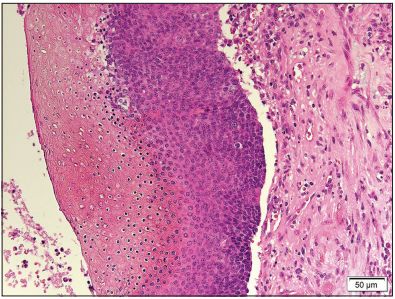- Home
- Solutions
- By Diseases
- Ocular Neoplastic Diseases
- Eyelid Pilomatrixoma

Eyelid pilomatrixoma is an uncommon and non-cancerous tumor that develops from the follicle hair cells. Protheragen provides end-to-end services for eyelid pilomatrixoma research, including diagnostics development, drug discovery, preclinical testing, and animal models.
Eyelid pilomatricoma is usually first identified in children and young adults. An eyelid pilomatrixoma neoplasm usually occurs as a mass in the periocular region that is firm, slow-growing, and painless. Additionally, this neoplasm can be found in the neck and head region, especially above the eyebrows and in the eyelids. The presentation of this painful condition includes bluish or reddish discoloration of the skin with chalky white nodules and a cylindrical mass that is fixed to the skin's surface and moves freely over the tissue beneath the skin. This condition mainly affects females.
 Fig.1 Histological findings showing basaloid cells differentiated from shadow cells. (Alturkistany W., et al., 2023)
Fig.1 Histological findings showing basaloid cells differentiated from shadow cells. (Alturkistany W., et al., 2023)
The eyelid pilomatrixoma tumor stems from abnormal overgrowth of the hair follicle matrix. Its histology shows basaloid and eosinophilic keratinized "shadow" cells, which are necrotic pieces of peripheral basaloid cells. There is usually calcification along with foreign body giant cells. At the molecular level, mutations of the CTNNB1 gene, which encodes β-catenin, are crucial because they activate the Wnt pathway, leading to uncontrollable proliferation. This change is observed in most sporadic cases and confirms the role of β-catenin in its pathogenesis.
Biopsy and Microscopy
The diagnosis is made from a histopathological examination which remains the gold standard. Diagnosis is confirmed on microscopy through the presence of basaloid cells, shadow cells, and calcification.
Genetic Testing
In suspected atypical cases, the diagnosis can be confirmed on a molecular level with the identification of CTNNB1 mutations.
| Therapeutics | Target | Description | Research Stage |
| Wnt/β-catenin Inhibitors | Wnt/β-catenin Pathway | Small molecule inhibitors or monoclonal antibodies targeting the Wnt/β-catenin pathway to suppress tumor growth. | Preclinical |
| Topical Retinoids | Keratinocyte Differentiation | Topical agents like tretinoin modulate keratinocyte differentiation, potentially reducing tumor size. | Discovery |
| Anti-inflammatory Agents | Inflammation Pathways | Investigated to reduce secondary inflammation and foreign body giant cell reactions in the tumor. | Discovery |
| Calcium Channel Blockers | Calcification Processes | Explored for their potential to inhibit calcification within the tumor. | Discovery |
Disclaimer: Protheragen focuses on providing preclinical research services. This table is for information exchange purposes only. This table is not a treatment plan recommendation. For guidance on treatment options, please visit a regular hospital.
Protheragen offers comprehensive diagnostics and therapeutics development services for eyelid pilomatrixoma. Our services include advanced histopathological evaluation and molecular diagnostics to ensure accurate diagnosis. We also provide cutting-edge therapeutic development, including targeted drug discovery and preclinical testing, to advance innovative therapeutics options.

Protheragen's preclinical research services are designed to accelerate the development of novel therapies for eyelid pilomatrixoma. Our team utilizes state-of-the-art in vitro and in vivo models to evaluate drug efficacy, safety, and mechanisms of action. If you are interested in our services, please feel free to contact us.
References